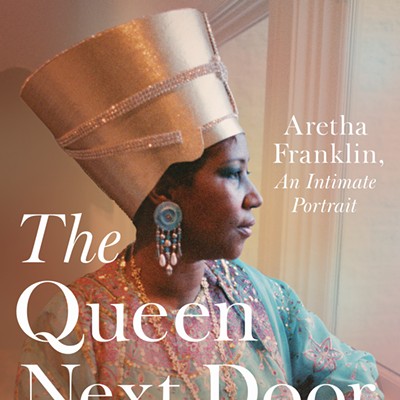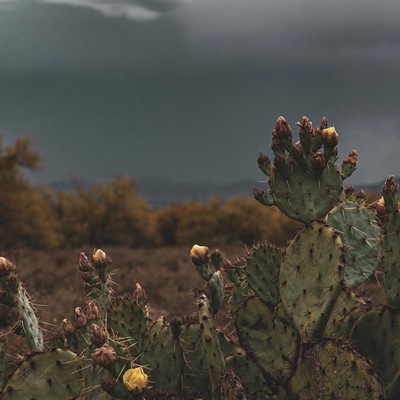Not a ray of sun penetrates the windowless cellar of the museum's old Toole Avenue warehouse, and with the help of a blasting swamp cooler, you can forget, sort of, the 106-degree temps baking the treeless pavement aboveground. And the art inside is way cool, too. Inspired by the cellar's weird nooks and crannies, the young photographers of Flashflood have deluged the place with up-to-the minute photographic experiments and installations, in a show called Space/Place/Environment.
Photographs dangle mid-air on wires strung to ceiling beams; they're bolted to Plexiglas; they're huge; they're tiny; they go in and out of focus. And in the case of Rebecca Horton's tribute to her aged Arkansas grandparents, they even sit in silver frames atop an old family sideboard. Best of all, on both cool-o-meters, is Rosanna Salonia's "Out of Place," an installation that conjures up a leafy forest complete with babbling brook.
Salonia has set up her soothing fantasy world inside one of the dark cubbies that line the cellar, spaces that may have been coal bins in a previous industrial life. When you enter Salonia's little room, your footsteps trigger a sound and light show. Water drips and gurgles soothingly on the soundscape; birds chirp. Flickering darks and lights coalesce into the moving image of a rushing stream on one wall; shade trees wave their branches welcomingly on another. Your own shadow becomes part of the show.
The pure pleasure of entering these dappled woods, incongruously set up in a desert that's as hot and dry and wretched as it's ever been, is very much to the point. Salonia, who's in a group show right now at the Los Angeles gallery Fototeka, has been exploring darker environmental themes for some time in her work. This time around, she reminds us that once in a while the natural world can be all bliss. The piece, she writes in an artist's statement, is a "celebration of the happiness that comes with being in a place of pure beauty." Her woods are lovely, dark and deep; they're designed to cheer us up and cool us off, and not a moment too soon.
The Flashflood group, founded by UA grad students about three years ago to promote experimental, mixed-media and traditional photography, has dwindled to five members from a high of a dozen or more. Now a "special project" of MOCA, a status that allows its members not only to show in the space but to apply for grants, Flashflood also has a small gathering of pictures in the Hotel Congress bar/lobby right now, on the theme of dry: or the desire for water.
The Space/Place show travels to more places than Salonia's forest. The itinerary ranges from McGehee, Arkansas, population 5,000, to New York City to Boulder to right here in Tucson. When Horton visited her grandparents in McGehee last year, she became entranced by the town's aging architecture, and came back with a series of fine gelatin silver prints of old mercantile buildings and deserted basements. The diptych "Interiors--Downtown McGehee, Arkansas" lovingly chronicles every brick and crack lining these empty spaces, places not unlike the vintage MOCA basement.
Kristin Giordano, who freelances as a photographer for the Tucson Weekly, has blown up evocative pictures of cheap New York hotel rooms, all chenille bedspreads and flimsy curtains. Centered on windows that allow light to flow in, these soft black-and-white pictures are surprisingly lovely. Less successful are her murky color prints of a bayou and a tree; similarly, Jessi Atwood's at-home shots of a man and woman are so blurry as to miss the mark.
You can sense the excitement of these young photographers trying out all the variations of their medium, allowing certain passages to stay crisp while letting others soften into painterly ambiguity. Sometimes their manipulations are haunting--as in the case of Giordano's "Sidewalk, Boulder, CO," in which an ordinary suburban street turned murky somehow suggests distant memory or times now lost. But sometimes, unfortunately, a blur is just a blur.
The photographers had fun putting together witty watery works for the haute-cool Hotel Congress watering hole. Horton provided a quartet of wet kisses, in color pictures shot in such close-up that they've become curvy abstractions. Atwood pulls off the same laudable trick, photographing thighs and calves in stark black and white, with the black closing in like a halo. The wet part? The pictures seem to have been taken in a tub. Diana Berntzen, whose only showing at MOCA is of a giant vertical "bed" of plastic sheets, here takes to the bedroom again in image transfer prints that look like black-and-white etchings. Her close-ups of a woman's face, and a man's reaching hands, naughtily conjure up the opposite of dry: the wetness of desire.
Salonia pictures a man in a boat in Mexico. Pointing out the deceptive beauty of pollution, Salonia has doctored the large black-and-white photo with sickly chemicals to turn the water sea-green. But Giordano throws herself into the surf more fully than any of the other Flashflooders. Her triptych "Deep Water" shows the sea and nothing but, an endless undulation of waves in gray, black and white. Stretching to infinity across the surface of her photographic paper, her ocean is so wet and cool a desperate desert dweller might be tempted to dive right in.














